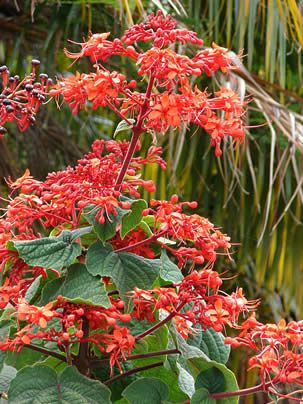The Flaming Glory Bower (Clerodendrum speciosissimum) is a shrubby plant with exuberant flowering, native to areas of Tropical Asia and Oceania, and has spread to other parts of the planet for its ornamental qualities. It features semi-herbaceous, erect, and branched branches and can reach about 4 meters in height, forming a small tree. Its leaves are heart-shaped, opposite, large, pubescent, dark green in color, shiny, and with irregularly serrated margins.
The inflorescences are of the panicle type, large, terminal, erect above the foliage, with numerous red, tubular, pentamerous flowers with long stamens. Flowering can extend throughout the year in a warm climate, but is concentrated in spring and summer in subtropical to temperate climates. The flowers, besides being beautiful, are also very attractive to bees and butterflies. The fruit is a drupe, initially red and turning black as it matures.

The C. speciosissimum is a very rustic and exuberant species, still little explored in landscaping. It can be planted alone, as well as in groups and rows. It is especially attractive along avenues, adorning the central flowerbed. Like some other species of clerodendrum, the Flaming Glory Bower also tends to escape cultivation control, as it continuously emits new shoots from the roots, gradually increasing the size of the clump.
For this reason, it is preferable to cultivate it in spaces restricted by a wall or pavement, in the corners of the garden, in a line around a grove of trees, in patios, and especially in pots, which can decorate sunny balconies and terraces.
The Flaming Glory Bower should be grown in full sun or partial shade, in any type of soil, but preferably fertile, enriched with organic matter, and irrigated regularly. Its foliage becomes denser under full sun, as does the flowering, which is more intense.
In subtropical or warm temperate climates, this species of clerodendrum behaves as deciduous, losing its leaves during the winter and sprouting vigorously in the spring. It multiplies by seeds, but mainly by separating the shoots that spontaneously emerge around the mother plant.

